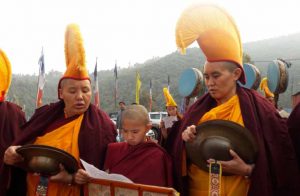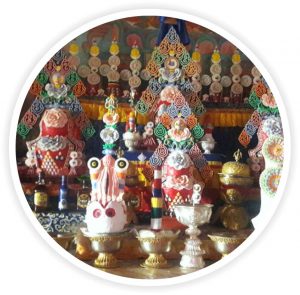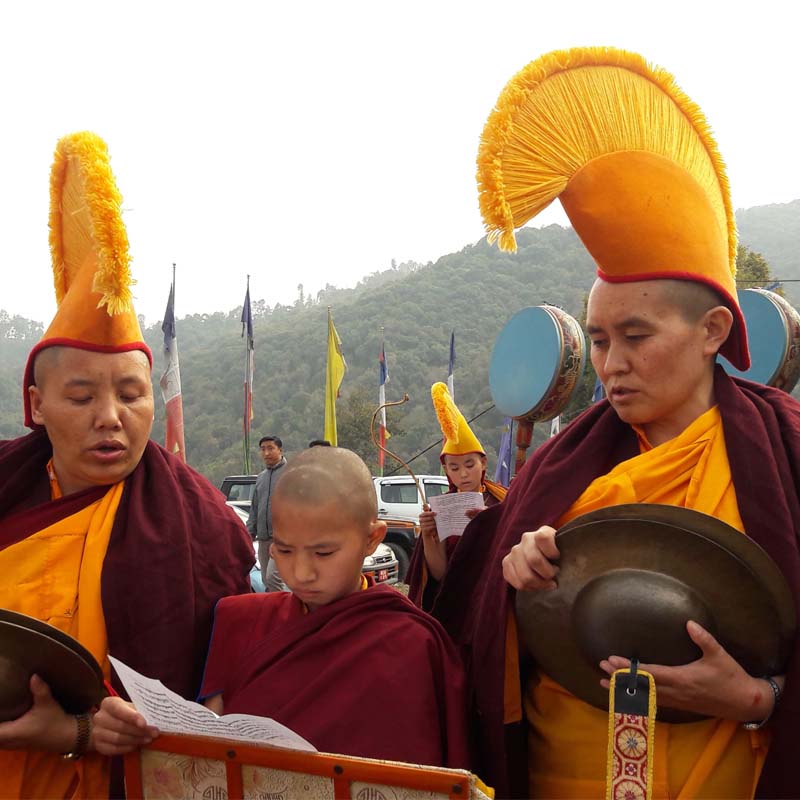
I spent the Lunar New Year and the succeeding month in a Tibetan Buddhist nunnery in the hills outside Kathmandu. There were no fireworks or astrological predictions, no hopeful statements of and resolutions for a good year ahead. It was, in summary, a nine-full-day prayer ceremony to greet the Lunar New Year. Full without any exaggeration – prayers from 3:30 a.m. to 8 p.m. every single day.
Mahakala
For the event called Gu-Tor (Tibetan: 9 Tormas), the main Buddhist deity celebrated is Mahakala (in Sanskrit, Gonpo Bernak in Tibetan).
He is very ugly, but fully enlightened and very powerful. Black, holding a curved knife and a blood-filled skull cup, he wears a 21-human skull necklace. He has a very big nose, bears his fangs and has a horrid look that will scare all your problems away – and that pretty much sums up why he is the main celebrant.
The entire day had three 20-minute breaks and an hour for lunch. The chantings were melodious and intense. The handheld drums were beaten rhythmically most of the time.
As I chanted with the nuns, I sensed that this contained the same elements of the usual prayers – but expanded.
The first eight days were exactly the same, so for a first-timer like me, it was like being in the movie “Inception.” First, I thought I might have been dreaming. Slowly I realized I was the dream!
By the fourth night, I was bored. So, I sneakily got hold of a romantic movie from the cook’s son and watched it way past bedtime. It was great, but I suffered the result the next day – I had a headache the whole day!
The nuns were very busy a few weeks before Gu-Tor, making infinite amounts of big and small colorful, intricate tormas. Tormas are cone-shaped figurines made from hardened barley powder. They serve as offerings for enlightened beings like Mahakala or ransom offerings to drive demons and evil spirits away.
There was great solidarity in making the tormas. The nuns would play One Direction music and make special snacks that were just mouth-watering. I would pretend to ask about the tormas, only to wait for them to share their snacks with me.
When Gu-Tor started, it was the turn of the kitchen staff to be very busy. The hearth was already glowing with burning firewood at 3 a.m. I was a regular visitor of the kitchen under the guise of toilet breaks. I would make tikim before any nun could taste the next dish.
Everyday saw the line-up of nine sets of meals and drinks for the nuns in the hall. I’m pretty sure the nuns knew why my toilet breaks were long.

Merit
Merit (Tibetan: so nam) is invisible so it is not as straightforward as money in the bank. Simply put, merit is the ability to see Truth.
In Buddhism, truth is not a vision of a deity, a prophetic dream or hearing God’s voice. To see truth is as simple as fully believing in one’s own death, or in the impermanence of things. To see death as ‘morbid’ or to have that ‘stoicism in the heart even if it is acceptable to the mind’ gut feeling may be signs of a lack of merit, a denial of the truth.
So, doing puja or praying to a deity creates merit, as are actions like chanting a Sutra, teachings of the Buddha (even without understanding it), respecting and serving the monastics and so on.
Gu-Tor is exceptionally formulated to earn lots of merit for the participants and the supporters.
The final day saw a surge of lay supporters flocking to the nunnery, mostly from the Mananggi community (Manang is the Nepali province where the Annapurna Range is located). The highlight of the event was dragging a five-foot consecrated torma outside to be burned.
This is the ransom offering for the inner and outer demons to leave the nunnery and its supporters. Sherab Gyaltsen Rinpoche, the nunnery’s spiritual head, officiated and finally brought the nine-day event to an end.
But the “fun” was just beginning. It is believed that the first month of the Lunar Year multiplies the effects of whatever good and bad is done during this time a hundred thousand fold. Thus the need to maximize this opportunity.
The Mani Dungyur
Held below the famous stupa in Swayambunath, this is a half-day prayer ceremony, from 6:30 a.m. to 6 p.m. On its 34th straight year, it is attended by 2,000 lay people, mostly from the Mananggi community. It was initiated by Rinpoche, an ethnic Mananggi, through the confluence of his and the Mananggi people’s devotion to Chenrezig (Chinese: Kuan Yin).
Chenrezig and his mantra, Om Mani Padme Hung, are the center of the Mani Dungyur. He is everything that Mahakala is not – pearl white, serene-looking, with hands folded in compassionate prayer.
Rinpoche is known to have recited the mantra more than a billion times already. For us who like quick fixes, don’t come here looking for faith healing or miracles.
The attendees simply chant the mantra 10,000 to 30,000 times a day.

Merit and the rationale mind
Merit is not valued in our society at all. Some will argue, “Why will I want to face death anyway when I am still young and healthy?”
Another truth is aging. We just love to stay young, but we know we can’t. For people interested in merit, complimenting each other about looking young is like monkeys stroking each others’ tails. No, it is not arrogance, it is just non-denial. So merit may not sound too irrational after all.
Rinpoche is uncompromising in keeping the heart of Buddhism intact. He still lectures every day over a public address system about bitter Buddhist pills like the reality of aging and the unpredictability of death, despite majority of the Mananggis being very successful business people.
I noticed that most of the Mananggi mothers can recite considerably long prayers and aspirations (more than half an hour of non-stop fast chant) by heart, though illiterate in written Tibetan.
I discovered that when the Mani Dungyur first started, the Rinpoche, then in his early 30s, would chant two lines during lunch break for the women (and men) to memorize.
Merit and pure perception
Jamgon Kontrul reiterates the Buddhist concept of Pure Perception (Tibetan: Dag-nang) in The Torch of Certainty. Pure Perception is the highest of Buddhist practices, if you ask the merit-inclined Buddhist.
Everything seen outside, pure or impure, is the product of a stained lens that one is wearing but is in denial of. As claimed by him, all we perceive outside is actually pure.
Another way to describe merit: Earning it cleans our severely stained lens to slowly achieve Pure Perception.
The idea is 100 percent applicable to modern living, but most of us apply it 100 percent the opposite way – we only see others as faulty whilst we see ourselves as perfection incarnated.
Conclusion
For the business of merit and pure perception, one should look up the annual back-to-back events of Gu-Tor and Mani Dungyur. Whether the main celebrant is White Chenrezig or Black Mahakala, the methods will earn you merit.
If you happen to visit either event in Nepal, you may be disappointed that Rinpoche, the nuns or the Mananggi community may speak and act a little more stained and imperfect than I have described.
Before you leave the gates, you may want to maximize your remaining moments by chanting a few (hundred thousand) Mani mantras, earn some merit, clean a little of your lens and maybe, be able to taste a sample of Pure Perception for yourself!





